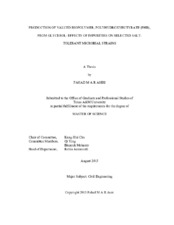| dc.description.abstract | Polyhydroxybutyrate (PHB) is a type of bioplastics with similar chemical and physical characteristics to petroleum-based plastics. However, the production cost of PHB is high, in part, due to expensive growth substrate. In this study, we explore the feasibility to reduce the production cost of PHB by using a cheap carbon source like crude glycerol, a waste stream from biodiesel industry. Crude glycerol contains undesirable impurities like salts and fatty acids that might be inhibitory to bacterial growth and/or PHB production.
Thus, this study examined the ability of salt-tolerant strains to grow on glycerol and the effects of glycerol impurities on the growth and PHB production by the glycerol-grown strains. Among four salt-tolerant bacteria (Azohydromonas lata, Pseudomonas oleovorans, Burkholderia sp., and Zobellella denitrificans ZD1), A. lata was unable to grow on 5 g/L of glycerol in the presence or absence of 0.5 g/L of NaCl. Z. denitrificans ZD1 accumulated the highest PHB content (84% g-PHB/g-dry cell weight) in 24 hours; while P. oleovorans and Burkholderia sp. accumulated 38% (g-PHB/g-dry cell weight) and 45% (g-PHB/g-dry cell weight) in 46 hours and 40 hours, respectively. The growth of P. oleovorans was slightly enhanced by the presence of fatty acids (stearate, oleate, and linoleate); however, no impacts on the growth and PHB content were observed for Burkholderia sp. When fatty acids was increased to 1% (w/w), delayed cell growth, lower maximum cell density (from 0.98 g/L to 0.68 g/L) and lower PHB content (from 84 to 71% (g-PHB/g-dry cell weight) were observed for Z. denitrificans ZD1. Effects of nitrogen source, electron acceptors, initial pH, and C/N ratios suggested that Z. denitrificans ZD1 was a favorable strain for PHB production using glycerol. Z. denitrificans showed the highest PHB content in the dry cell weight, 84%, the shortest utilization period, 24 hours, even under the influence of fatty acids. The strain also can accumulate PHB using nitrate as a nitrogen source and electron acceptor. | en |


